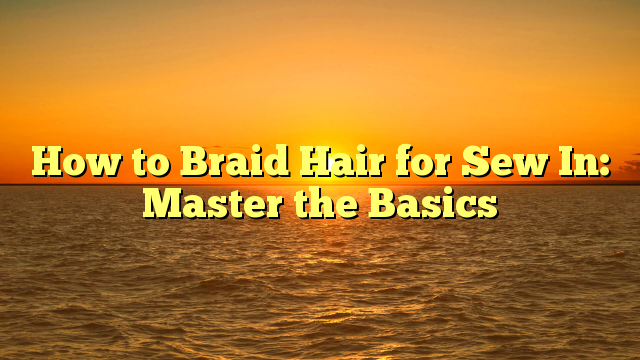How to Braid Hair for Sew In
Understanding the Sew-In Technique: A Step-by-Step Guide
The sew-in technique is a popular method used for adding length and volume to your hair. It involves attaching wefts of hair extensions to your natural hair by sewing them in with a needle and thread. This method is preferred by many because it allows for a natural-looking and long-lasting hairstyle.
To start, you will need to wash and condition your hair to ensure it is clean and free of any product buildup. Next, you will want to section off your hair into neat and even parts to make it easier to work with. Then, you can begin braiding your hair in a pattern that will serve as the foundation for the sew-in. The most common technique is the cornrow method, where your hair is braided close to the scalp in rows. Once your braids are in place, you can begin sewing in the wefts of hair extensions, ensuring they are secure but not too tight. With the sew-in complete, you can style your hair as desired, whether it’s sleek and straight or curly and voluminous.
How to Braid Hair for Sew In
Preparing Your Hair for a Sew-In: Essential Tips and Tricks
Before getting started with your sew-in, it is crucial to properly prepare your hair to ensure a seamless and long-lasting result. Here are some essential tips and tricks to help you through the prepping process.
First and foremost, it is important to thoroughly cleanse your hair before the sew-in installation. Use a clarifying shampoo to remove any product build-up, dirt, or oils that may be present. Follow up with a deep conditioning treatment to restore moisture and strengthen your strands. This step will not only promote healthy hair growth but also create a clean and ideal environment for the sew-in to be attached securely.
Next, it’s time to focus on achieving a smooth surface for the sew-in. Detangle your hair gently with a wide-tooth comb or detangling brush, starting from the ends and working your way up to the roots. This will minimize any potential breakage or damage. Additionally, a trim may be necessary to get rid of split ends, ensuring a neater and more polished finish. By taking these essential steps prior to your sew-in, you are setting yourself up for a flawless and comfortable experience.
How to Braid Hair for Sew In
Different Types of Braids for Sew-In: Choosing the Right Style
When it comes to choosing the right style for your sew-in, there are a variety of braid options to consider. Each type of braid brings its own unique look and feel to your sew-in, allowing you to customize your style to suit your preferences. Whether you’re going for a sleek and polished look or a more textured and natural vibe, it’s important to choose a braid that will complement your desired outcome.
One popular option for a sew-in is the classic cornrow braid. This technique involves braiding the hair close to the scalp in neat rows, creating a foundation that securely holds the extensions in place. Cornrows are not only versatile and long-lasting, but they also allow for easy styling and maintenance. If you prefer a more laid-back and effortless look, the cornrow technique is a great choice for your sew-in.
How to Braid Hair for Sew In
Sectioning Your Hair: The Key to a Flawless Sew-In
Sectioning your hair properly is a crucial step in achieving a flawless sew-in. Taking the time to divide your locks into neat and tidy sections will not only ensure a seamless installation but also make the maintenance and styling process much easier. To begin, start by thoroughly detangling your hair with a wide-tooth comb, removing any knots or tangles. This will make the sectioning process more manageable and prevent any unnecessary pulling or breakage. Next, using the end of a rat-tail comb, create a clean, straight part from the center of your hairline to the nape of your neck. This will serve as your guideline for the rest of the sections. Divide the hair on each side of the part into halves or thirds, using hair clips or rubber bands to keep them separate. Remember to make your sections as even and symmetrical as possible for a professional and polished finish.
The size of the sections will depend on the amount of hair you have and the style you want to achieve. For a natural and voluminous look, opt for smaller sections, as this will allow for closer placement of the extensions. Conversely, if you prefer a more relaxed and lightweight style, larger sections may be more suitable. Moreover, consider the braid pattern you plan to use, as this will also influence the size and placement of your sections. Whether you choose a traditional cornrow, French braid, or Dutch braid technique, the key is to create neat and uniform sections that will provide a solid foundation for your sew-in. Additionally, keep in mind that the direction of your sections should follow the natural growth pattern of your hair, ensuring a seamless blend between your real and extension hair. By paying close attention to the sectioning process and giving it the time and care it deserves, you are setting yourself up for a flawless sew-in that will look and feel amazing.
How to Braid Hair for Sew In
The Cornrow Technique: Mastering the Foundation for Sew-In
Cornrows are an integral part of the sew-in technique, serving as the foundation on which the extensions will be attached. Mastering the cornrow technique is crucial in ensuring that your sew-in looks flawless and lasts a long time.
To begin, make sure your hair is clean and dry before starting. Start by parting your hair into small sections and sectioning off the area where you intend to attach the extensions. Take a small section of hair at the front, divide it into three strands, and start braiding in a downward motion, adding hair from the root as you go. Keep the braids close to the scalp to create a flat and secure base for the sew-in. Continue this process until all the desired sections are cornrowed, and you’re ready to move on to attaching the extensions.
Attaining a neat and uniform cornrow pattern can take practice, especially if you’re doing it yourself. It’s essential to be patient and take your time. Remember to keep the tension even throughout the braids to avoid discomfort or breakage. Once you’ve mastered the cornrow technique, you’ll be well-equipped to move on to the next step of achieving a flawless sew-in. With a strong foundation in place, you can now focus on exploring different braiding patterns and creating unique looks with your sew-in.
How to Braid Hair for Sew In
Box Braids for Sew-In: Achieving a Versatile and Natural Look
Box braids are a popular choice for achieving a versatile and natural look when it comes to sew-in hairstyles. These braids are known for their versatility, as they can be styled in various ways to suit any occasion. Whether you prefer a sleek, sophisticated look or a more laid-back and casual appearance, box braids can easily be adapted to meet your style needs.
One of the reasons why box braids are so popular for sew-in styles is their natural look. The braids are typically installed close to the scalp, creating a seamless and natural appearance. This makes them a great option for those who want to add length and volume to their hair without it looking obvious or artificial. With proper maintenance and care, box braids can also last for several weeks, making them a practical choice for anyone looking for a long-lasting sew-in style.
The French Braid Method: Adding Elegance to Your Sew-In
Adding elegance to your sew-in can be achieved through the French braid method. This technique not only adds sophistication to your overall look but also provides a secure foundation for your sew-in extensions. The French braid involves weaving sections of hair over one another, creating a beautiful intertwined pattern. It is a versatile style that can be worn for both formal and casual occasions, making it a popular choice for many.
When using the French braid method for your sew-in, it is important to start with clean and detangled hair. This will ensure a smooth and seamless braid. Begin by parting the hair into sections and securing the rest of the hair out of the way. Divide a small section at the front into three equal parts and begin the braid by crossing the right section over the middle, then the left section over the middle. As you continue braiding, gradually incorporate more hair from the sides into each section. This will create a tight and secure braid that will hold your sew-in extensions in place while adding an elegant touch to your overall look.
How to Braid Hair for Sew In
Dutch Braids for Sew-In: Creating a Chic and Trendy Appearance
Dutch braids are a fantastic option for creating a chic and trendy appearance with your sew-in hairstyle. These braids, also known as inverted or inside-out braids, are created by crossing the strands under each other instead of over. This technique results in a braid that sits on top of the hair rather than being woven into it, offering a unique and eye-catching look.
One of the best things about Dutch braids is their versatility. They can be worn in a variety of styles and sizes, allowing you to customize your sew-in to suit your personal taste and desired look. Whether you prefer a sleek and polished braid or a more voluminous and textured style, Dutch braids can be adapted to achieve the perfect appearance. Additionally, these braids can be incorporated into different patterns and designs, further enhancing the overall visual appeal of your sew-in hairstyle. So, if you’re looking to create a chic and on-trend look, consider opting for Dutch braids for your sew-in.
Tips for Braiding Extensions: Ensuring Longevity and Durability
When it comes to braiding extensions for a sew-in, ensuring longevity and durability is key. Here are a few tips to help you achieve a long-lasting and secure style.
Firstly, make sure to prepare your hair properly before braiding. This includes washing and conditioning your hair thoroughly to ensure it is clean and moisturized. Additionally, detangling your hair with a wide-tooth comb or brush will help eliminate any knots or tangles, making the braiding process smoother.
Next, consider the tension applied while braiding. It is important to maintain a consistent and even tension throughout the braiding process. Avoid pulling too tightly, as this can lead to unnecessary stress on the hair and scalp, potentially causing breakage or discomfort. Finding the right balance of tension will not only improve the longevity of your braids but also promote healthy hair growth.
How to Braid Hair for Sew In
Enhancing Your Sew-In with Creative Braiding Patterns
One way to take your sew-in hairstyle to the next level is by incorporating creative braiding patterns. These patterns not only add visual interest and dimension to your hairstyle but also help to secure the extensions in place. There are numerous options to choose from, allowing you to customize your sew-in and create a unique look that suits your personal style.
One popular braiding pattern for sew-ins is the diagonal pattern. This involves braiding the hair at an angle, creating a diagonal line across the scalp. This pattern works well for adding volume and depth to your sew-in, as it allows the extensions to be distributed evenly and seamlessly. Another option is the circular pattern, which involves braiding the hair in a circular shape, starting from the center of the scalp and working outwards. This pattern creates a beautiful and symmetrical look, perfect for those who want a more intricate and eye-catching sew-in style.



